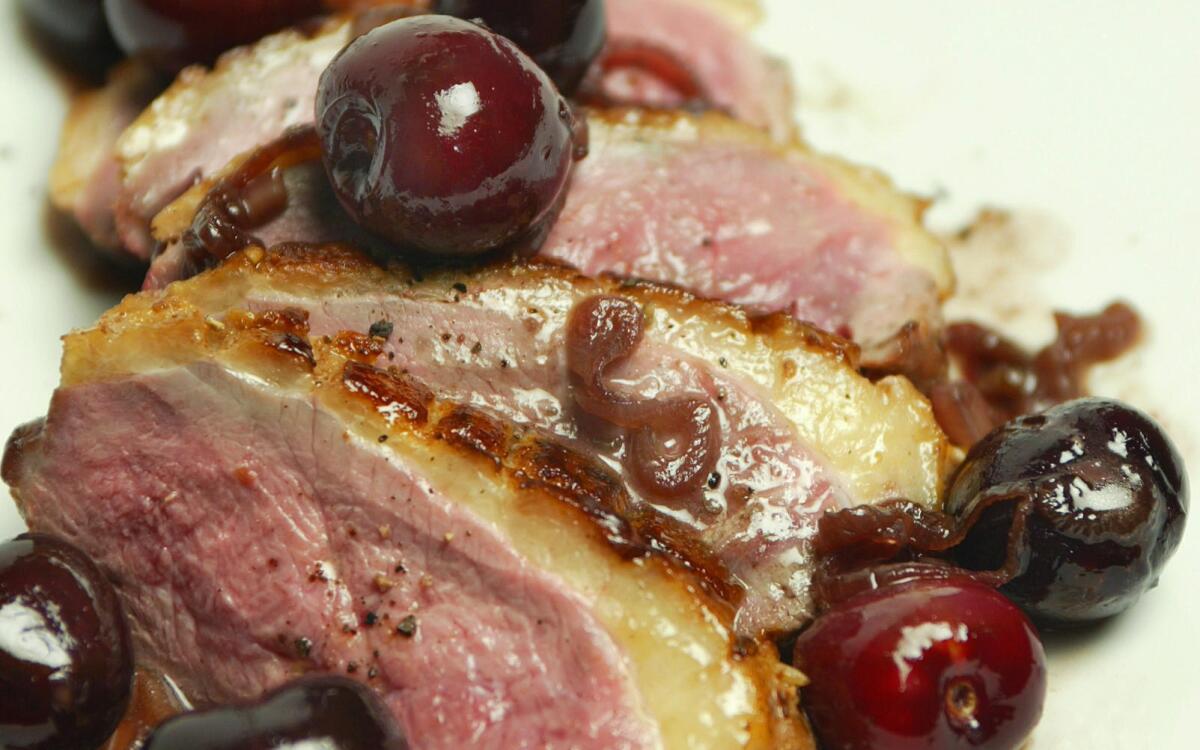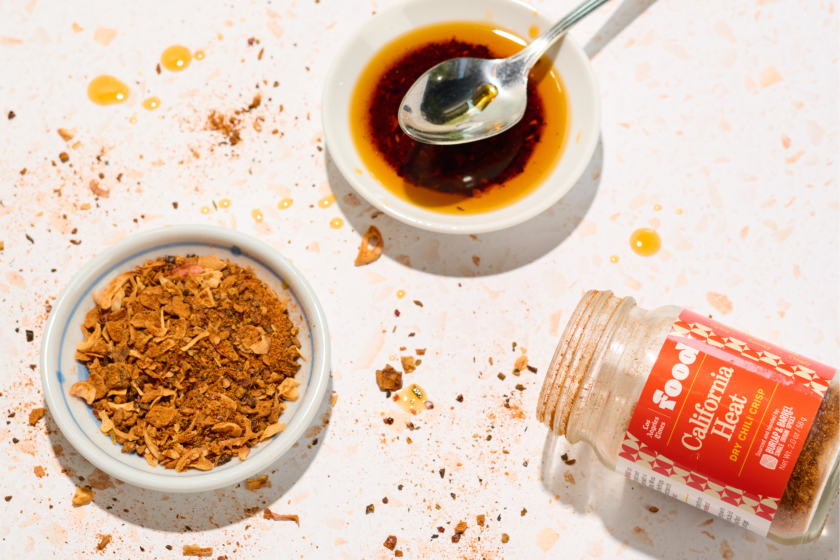Duck breasts with pan-roasted cherries

This time last year, I began a trip through the French countryside that would last all summer. It was no longer spring, but it wasn’t quite summer either. It was that bonus in-between season called cherry.
My first guesthouse was on a patch of land called, fittingly enough, Clos des Cerisiers (“field of the cherry trees”) in a tiny Perigord town. The house, a converted barn, was ringed by fruit trees. But as soon as my traveling companions and I arrived, our hosts -- knowing what a name like that conjured in our imaginations -- apologized profusely. The birds, they said, had swooped down a week ago and eaten every last cherry.
I looked wistfully at the fruit-bare trees. If only we had arrived earlier.
So I wasted no time in the next month. I picked cherries off roadside trees whenever I could. I helped myself to a bottomless bowl of them at a farmhouse B&B. I ordered any dessert that had cherries in it -- clafouti, flan des fruits, you name it. In short, I ate them as if I would never see them again.
This season, back in L.A., I am only slightly more restrained. I’ve devoured them, straight from the farmers market, and was happy to spend the rest of the season popping them fresh. Then I tasted something brilliant at AOC -- roasted cherries.
“Roasting softens them up and develops the flavor a little more, bringing out the sugars,” says chef de cuisine Daniel Mattern. He uses roasted cherries as a finishing touch for a spectacular little salad. He layers endive, radicchio and frisee made smoky by grilling, Serrano ham sliced paper thin and wild arugula, then he sprinkles over some almonds and the roasted cherries.
They’re not cooked beyond recognition but to perfection. You bite into a roasted cherry and get a bit of resistance as you would from its unroasted skin, but inside, it’s a different story. The fruit’s juicy flesh melts warmly in your mouth, releasing a cherry sweetness with a hint of almond flavor.
Mattern dresses the salad with extra virgin olive oil, almond oil and noble sour, which is an Austrian vinegar made from the Pedro Ximenez sherry grape. “Every time I taste it, I think of cherries,” Mattern says. But considering noble sour costs around $50 for 250 milliliters, or about 7.5 ounces, Mattern says that aged balsamic vinegar is a fine substitute; in fact, it’s what Mattern used when he first put the dish on the menu while waiting for delivery of the hard-to-find noble sour.
There’s a lot going on in this salad, but the flavors (sweet, smoky, salty, bitter and sour) pull together beautifully. And Mattern says he deliberately doesn’t stem the fruit, an invitation “for people to grab a stem and eat a cherry just like that.”
Mattern isn’t the only chef roasting cherries. Chris Kidder, executive chef at Literati II in L.A., likes to serve juicy, roasted cherries with a thick pork chop made succulent by brining. He garnishes the dish with fried and grilled leeks and serves a potato and walnut gratin alongside.
To roast the cherries, he splashes olive oil and port vinegar in the pan and adds a few sprigs of thyme. “It’s good to be able to cook things with the pit and the stem,” Kidder says. Roasting cherries whole draws a hint of the bitterness from the pit; serving them with their stems adds visual appeal.
Campanile pastry chef Dahlia Solomon adds a little kirsch to her roasting pan, then serves the cherries and its juices around a slice of gateau basque. The cherries pair naturally with the tart’s almond pastry cream filling. “I like to keep the cherries nice and plump,” she says. “They’re great over ice cream too.”
Roasting cherries couldn’t be easier. There’s no pitting or slicing involved, and it takes just a few minutes. So of course I had to try it at home -- and immediately. Cherries are starting to dwindle at local farmers markets, though we can enjoy them for a little longer as growers to the north send them our way.
Reminiscing about my French trip that began with cherries got me to thinking how it ended with duck breasts -- and this inevitably led to a craving to have those two things together. My last stop was near the town of Mirepoix, just shy of the Spanish border, where the meaty magret de canard, from fatted ducks raised for foie gras, is a specialty.
In my quest to replicate it as I had it there, I found a terrific pan-roasting technique in a cookbook by Paula Wolfert. It’s simple and foolproof. I sear the meaty side of the duck, turn it onto its skin side for 15 minutes, then flip it over to finish. I don’t even have to multi-task: The five-minute resting period before slicing is all I need to roast cherries in the same skillet.
As with roasting cherries in the oven, pan-roasting is quick work. In either case, pull the cherries from the heat after just a few minutes. Their skins should be intact, holding in all that luscious juiciness. So don’t let them split or pop.
That way, you make every cherry count -- as you should. It’s such a short season, after all.
Take the duck breasts out of the refrigerator about 30 minutes before cooking and allow to come to room temperature. Remove any silver skin from the meat. Rinse and pat dry. Using a sharp knife, score the skin in a crisscross pattern without cutting into the meat. Sprinkle the skin with salt and pepper. Cover with plastic wrap until ready to cook.
Melt the butter in a large nonstick skillet. Add the duck breasts, skin side up, and sear over medium-high heat, about 2 minutes. Add 2 tablespoons stock to deglaze the pan, letting the liquid boil for about 1 minute.
Turn the duck breasts skin side down. Season the meat side with salt and pepper. Reduce the heat to low and cook for 15 minutes without turning the breasts. As it cooks, the skin will crisp and render fat. Turn the breasts over again and cook the meat side until done (it will feel springy to the touch), about 2 to 3 minutes for medium rare.
Remove the breasts from the pan, placing them on a warm platter. Cover loosely with foil.
Carefully pour out the rendered fat into a small metal bowl.
Place 2 teaspoons of the fat into the same skillet. Over medium heat, add the shallots and saute until fragrant, 30 seconds to 1 minute.
Add the cherries, and raise the heat to high. Pan-roast the cherries, shaking to cook evenly, about 2 to 3 minutes (do not let the skins pop). Remove from heat. Add to the pan the remaining 2 to 3 tablespoons stock, plus the juices that the duck breasts have released.
Slice the duck breasts into one-third-inch-thick slices, cutting at a diagonal starting at the narrower end. Transfer to a warm platter, slightly fanning the slices. Sprinkle with freshly ground black pepper and spoon the cherries over.
Get our Cooking newsletter.
Your roundup of inspiring recipes and kitchen tricks.
You may occasionally receive promotional content from the Los Angeles Times.















